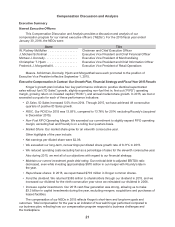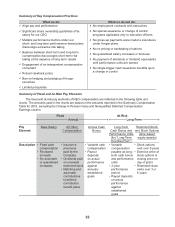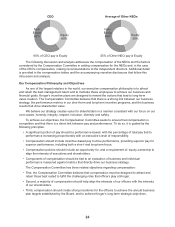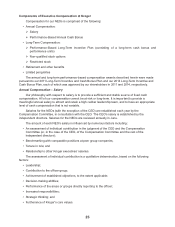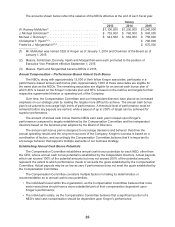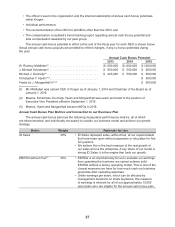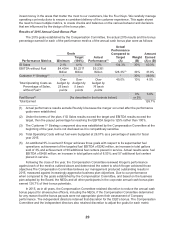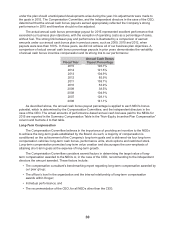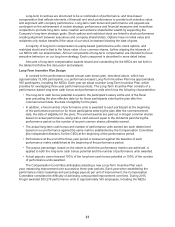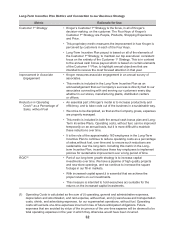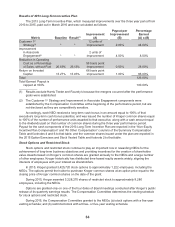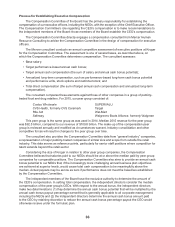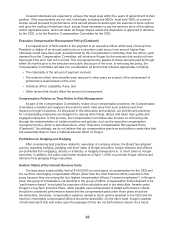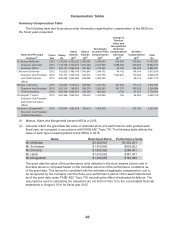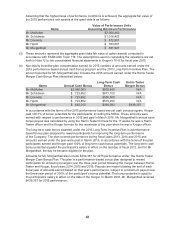Kroger 2015 Annual Report Download - page 33
Download and view the complete annual report
Please find page 33 of the 2015 Kroger annual report below. You can navigate through the pages in the report by either clicking on the pages listed below, or by using the keyword search tool below to find specific information within the annual report.31
Long-term incentives are structured to be a combination of performance- and time-based
compensation that reflects elements of financial and stock performance to provide both retention value
and alignment with company performance. Long-term cash bonus and performance unit payouts are
contingent on the achievement of certain strategic performance and financial measures and incentivize
recipients to promote long-term value creation and enhance shareholder wealth by supporting the
Company’s long-term strategic goals. Stock options and restricted stock are linked to stock performance
creating alignment between executives and company shareholders. Options have no initial value and
recipients only realize benefits if the value of our stock increases following the date of grant.
A majority of long-term compensation is equity-based (performance units, stock options, and
restricted stock) and is tied to the future value of our common shares, further aligning the interests of
our NEOs with our shareholders. All four components of long-term compensation are intended to focus
executive behaviors on our long-term strategy. Each component is described in more detail below.
Amounts of long-term compensation awards issued and outstanding for the NEOs are set forth in
the tables that follow this discussion and analysis.
Long-Term Incentive Plan Design
In contrast to the performance-based annual cash bonus plan, described above, which has
approximately 13,000 participants, our performance-based Long-Term Incentive Plan has approximately
160 participants, including the NEOs. Each year we adopt a similar Long-Term Incentive Plan, which
provides for overlapping three year performance periods. The Long-Term Incentive Plan consists of a
performance-based long-term cash bonus and performance units which has the following characteristics:
• The long-term cash bonus potential is equal to the participant’s salary at the end of the fiscal
year preceding the plan effective date (or for those participants entering the plan after the
commencement date, the date of eligibility for the plan).
• In addition, a fixed number of performance units is awarded to each participant at the beginning
of the performance period (or for those participants entering the plan after the commencement
date, the date of eligibility for the plan). The earned awards are paid out in Kroger common shares
based on actual performance, along with a cash amount equal to the dividends paid during the
performance period on the number of issued common shares ultimately earned.
• The actual long-term cash bonus and number of performance units earned are each determined
based on our performance against the same metrics established by the Compensation Committee
(the independent directors, for the CEO) at the beginning of the performance period.
• Performance at the end of the three-year period is measured against the baseline of each
performance metric established at the beginning of the performance period.
• The payout percentage, based on the extent to which the performance metrics are achieved, is
applied to both the long-term cash bonus potential and the number of performance units awarded.
• Actual payouts cannot exceed 100% of the long-term cash bonus potential or 100% of the number
of performance units awarded.
The Compensation Committee anticipates adopting a new Long-Term Incentive Plan each
year, measuring improvement over successive three-year periods. Each year when establishing the
performance metric baselines and percentage payouts per unit of improvement, the Compensation
Committee considers the difficulty of achieving compounded improvement over time. During 2015,
Kroger awarded 503,276 performance units to approximately 160 employees, including the NEOs.


